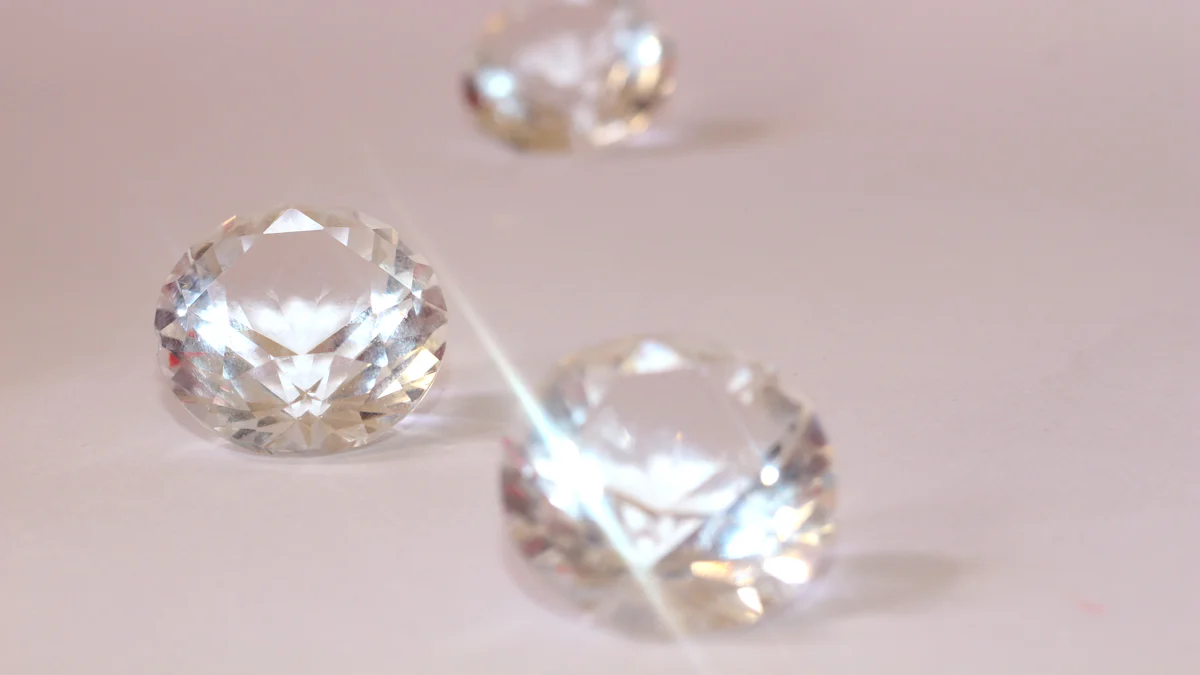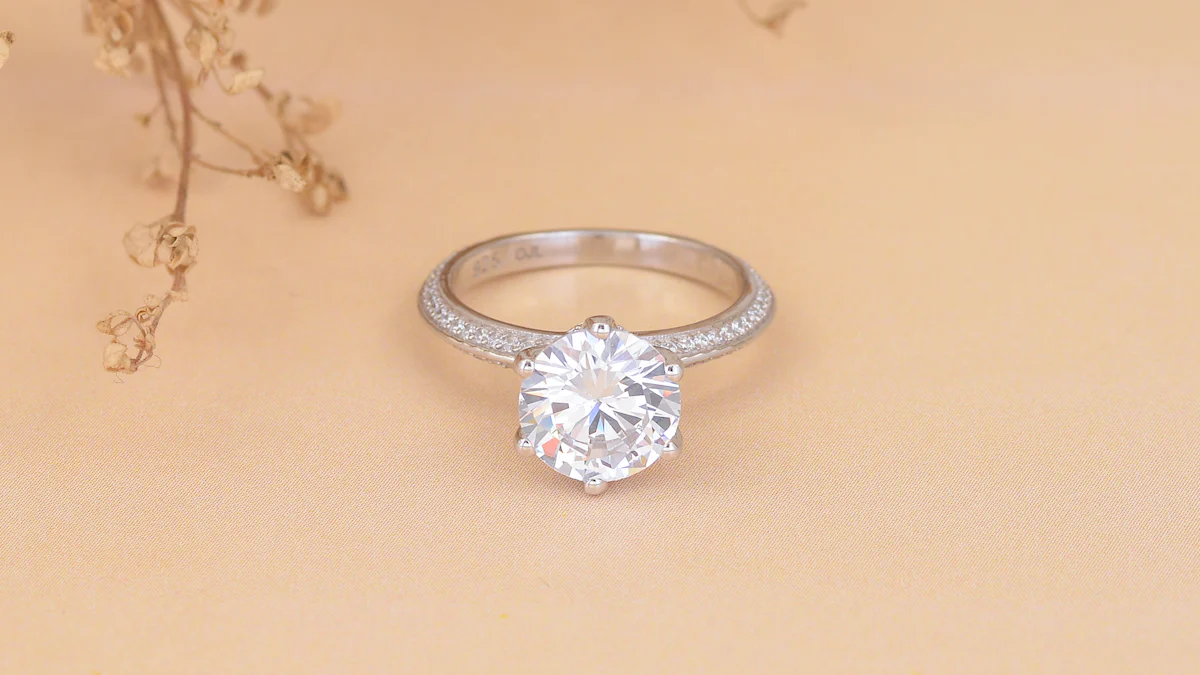Factors Influencing 2 Carat Natural Diamond Price

When buying a diamond, you may wonder how much does a diamond cost and why prices vary so much. The 2 carat natural diamond price depends on several factors that determine its beauty and rarity. The 4Cs—cut, color, clarity, and carat weight—play a major role. Additional elements like shape, fluorescence, and certification also influence the value. By understanding these aspects, you can make smarter choices and find a diamond that fits your budget and preferences.
The 4Cs and Their Role in Determining 2 Carat Diamond Price

Cut
The cut quality of a diamond has the most significant impact on its brilliance and overall appearance. A well-cut diamond reflects and refracts light effectively, creating dazzling brilliance, fire, and scintillation. These qualities make the diamond sparkle and appear more vibrant. Poorly cut diamonds, on the other hand, fail to reflect light properly, resulting in a dull and lifeless look.
Several factors influence cut quality:
- Proportions, such as table size and depth.
- Symmetry of the diamond’s facets, which act like tiny mirrors.
- Brilliance, or the reflection of white light.
- Fire, which refers to the dispersion of colored light.
- Scintillation, or the sparkle when the diamond moves.
Diamonds with excellent or ideal cut grades command higher prices due to their precision and rarity. When buying a 2 carat diamond, prioritize cut quality to ensure maximum brilliance and value.
Color
The color of a diamond refers to the presence or absence of color within the stone. The Gemological Institute of America (GIA) uses a grading scale from D (completely colorless) to Z (light yellow or brown). Diamonds graded D-F are the most valuable because they appear colorless, which is rare.
Color significantly impacts the price of a 2 carat diamond. Diamonds with D-F grades combined with high clarity fetch premium prices. However, diamonds in the G-H range offer a near-colorless appearance at a more affordable price. Choosing a slightly lower color grade can help you save money without compromising the diamond’s beauty.
Clarity
Clarity measures the presence of internal flaws (inclusions) or external blemishes in a diamond. Flawless (FL) and Internally Flawless (IF) diamonds are extremely rare and highly valued. However, many inclusions are microscopic and invisible to the naked eye, making lower clarity grades like VS1 or VS2 excellent options for balancing quality and cost.
Clarity plays a crucial role in determining the price of two-carat diamonds. While higher clarity grades increase the price, you can find great value in diamonds with slight inclusions that don’t affect their visual appeal.
By understanding the 4 C's of diamonds—cut, color, and clarity—you can make informed decisions and find the perfect balance between quality and budget when purchasing a 2 carat diamond.
Carat Weight
Carat weight measures the size of a diamond. It refers to the actual weight of the stone, with one carat equaling 0.2 grams. For a 2 carat diamond, the weight doubles, making it a significant factor in determining price. Larger diamonds are rarer, which increases their value.
💡 Tip: A diamond’s carat weight doesn’t always reflect its visual size. Two diamonds with the same weight can appear different in size due to their cut and shape.
Carat weight has a direct impact on price. As the carat weight increases, the price per carat rises exponentially. For example, a 2 carat diamond costs much more than two 1 carat diamonds of similar quality. This is because larger diamonds are harder to find and cut without flaws.
When choosing a 2 carat diamond, consider how carat weight affects the overall look. A well-cut diamond may appear larger than its actual weight due to its brilliance and proportions. On the other hand, a poorly cut diamond might look smaller despite its weight.
Here are some key points to keep in mind:
- Price per carat: Larger diamonds have a higher price per carat.
- Balance: Focus on cut quality and proportions to maximize the diamond’s appearance.
- Budget: Slightly reducing the carat weight (e.g., 1.9 carats) can save money without a noticeable size difference.
✨ Note: Carat weight is just one of the 4Cs. Prioritizing cut, color, and clarity can help you find a diamond that looks stunning, even if it’s slightly smaller.
Understanding carat weight helps you make informed decisions. By balancing size with other factors, you can find a diamond that fits your budget and preferences.
Additional Factors That Impact the Price of a 2 Carat Diamond
Diamond Shape
The shape of a diamond significantly affects its price and visual appeal. Round brilliant diamonds are the most popular and expensive due to their high demand and the amount of rough diamond lost during cutting. However, fancy shapes like Asscher, Radiant, and Emerald cuts offer a more affordable alternative while maintaining elegance.
Here’s a comparison of popular diamond shapes and their approximate prices:
| Diamond Shape | Price (Approx.) | Price Comparison to Round Cut | |----------------|------------------|-------------------------------| | Asscher Cut | $2,500 | 50% less | | Radiant Cut | $3,604 | 32% less | | Emerald Cut | $2,825 | 46% less | | Princess Cut | $3,263 | 38% less | | Cushion Cut | $3,150 | 40% less |
Choosing a fancy shape can help you save money without compromising beauty. For example, an Emerald cut offers a timeless look at nearly half the price of a round diamond.
Fluorescence
Fluorescence refers to how a diamond reacts to ultraviolet (UV) light. This characteristic can influence both the appearance and value of a diamond.
- Diamonds graded D to H with very strong fluorescence often sell for less because some buyers associate fluorescence with haziness.
- On the other hand, fluorescence can enhance the appearance of diamonds in the I to M color range, making them appear up to one grade whiter. These diamonds may even sell at a slight premium when they have medium to very strong fluorescence.
Understanding fluorescence helps you evaluate whether it adds or detracts from a diamond’s value. For a 2 carat natural diamond price, fluorescence can be a key factor to consider.
Certification
A diamond certificate, also known as a grading report, provides an objective evaluation of a diamond’s quality based on the 4Cs. Reputable certifications, such as those from the Gemological Institute of America (GIA), assure you of the diamond’s authenticity and quality.
A diamond certification serves as a reliable way to communicate a diamond’s unique features to potential buyers, helping them make informed purchasing decisions.
Certification protects you from fraud and ensures the diamond’s value over time. It also plays a crucial role in resale value and insurance. Without certification, you risk overpaying or purchasing a diamond of lower quality than advertised. Always prioritize certified diamonds to ensure confidence in your purchase.
Understanding the Price Ranges for Two-Carat Diamonds
Typical Price Ranges
The price of a 2 carat diamond can vary widely based on its quality and characteristics. On average, you can expect prices to range from $5,000 to over $60,000. Several factors influence this variation, including the diamond's cut, clarity, color, and carat weight. The setting and design of the ring also play a role in determining the final cost.
Here’s a breakdown of what you might encounter:
- Lower-quality two-carat diamonds, with visible inclusions or noticeable color, may cost as little as $4,000.
- Mid-range diamonds, offering a balance of quality and value, typically fall between $10,000 and $20,000.
- High-quality two-carat diamonds, featuring excellent cut, colorless appearance, and flawless clarity, can exceed $30,000.
Understanding these price ranges helps you answer the question, "how much does a diamond cost?" It also allows you to set realistic expectations when shopping for a 2 carat diamond.
Real-World Examples
Real-world examples provide a clearer picture of how the 4Cs and other factors impact the price of a 2 carat diamond. For instance:
- A flawless, colorless, perfectly cut two-carat diamond may cost around $20,000.
- A diamond with slight inclusions and a faint color might be priced at $10,000 or less.
- The median price of two-carat diamonds is approximately $12,825.
Prices can also vary significantly based on market trends and demand. For example:
- The lowest price recorded for a two-carat diamond is $4,993.
- The highest price recorded is $26,266.
If you’re looking for the best value, consider diamonds with slight inclusions or near-colorless grades. These options often look stunning while costing significantly less than flawless diamonds. Reviewing a 2 carat diamond price chart can also help you compare options and find the perfect balance between quality and budget.
By understanding these examples, you can better navigate the market and make informed decisions about the price of a 2 carat diamond.
Practical Tips for Buying a 2 Carat Diamond Ring
Focus on Value, Not Perfection
When buying a 2 carat diamond ring, focus on value rather than chasing perfection. A flawless diamond may seem appealing, but it often comes with a hefty price tag. Instead, look for diamonds with slight inclusions or near-colorless grades. These imperfections are usually invisible to the naked eye and can significantly lower the price.
For example, a diamond with a VS1 clarity grade and G color grade offers excellent visual appeal without the premium cost of flawless or colorless diamonds. You can also explore diamonds with slightly lower carat weights, such as 1.9 carats, to save money while maintaining the appearance of a 2 carat diamond. This approach helps you understand how to lower the price of a 2 carat diamond without compromising its beauty.
💡 Tip: Prioritize cut quality over other factors. A well-cut diamond maximizes brilliance, making it appear more vibrant and valuable.
Consider Fancy Shapes
Round diamonds dominate the market, accounting for 75% of all diamond sales and 60% of engagement rings. However, their popularity comes at a cost. Round diamonds can be up to 65% more expensive than fancy shapes like princess, cushion, or emerald cuts.
Fancy-shaped diamonds offer a unique look and better value. For instance:
- A 1.00-1.49 carat round diamond with G VS1 quality costs around $8,600 per carat.
- A comparable princess cut diamond costs $6,700, making it at least 30% less expensive.
While fancy shapes may not match the fire and brilliance of round diamonds, they still provide elegance and individuality. Choosing a fancy shape is a smart way to lower the price of a 2 carat diamond while creating a distinctive 2 carat engagement ring.
Buy Certified Diamonds
Always buy certified diamonds to ensure quality and authenticity. Reputable certification bodies like the Gemological Institute of America (GIA) and the American Gem Society (AGS) use rigorous grading standards. Their certificates provide consistent evaluations of a diamond’s cut, color, clarity, and carat weight.
A certified diamond gives you confidence in your purchase and protects you from overpaying. It also ensures the diamond retains its value over time. When deciding where to buy a 2 carat diamond, choose retailers that offer GIA or AGS-certified stones. This guarantees you’re investing in a diamond that meets high standards of diamond grading.
🛡️ Note: Avoid uncertified diamonds. Without proper documentation, you risk buying a diamond of lower quality than advertised.
By following these tips, you can make informed decisions when buying a 2 carat diamond ring. Focus on value, explore fancy shapes, and prioritize certified diamonds to find the perfect balance between quality and cost.
Comparing Natural and Lab-Grown Diamonds

Key Differences
Natural and lab-grown diamonds share the same chemical composition. Both consist of carbon atoms arranged in a crystalline lattice structure, giving them identical hardness and brilliance. However, their origins set them apart. Natural diamonds form deep within the Earth over billions of years, while lab-grown diamonds are created in controlled environments using advanced technology.
To the naked eye, these diamonds may look identical. Under a microscope, though, their inclusions reveal their differences. Natural diamonds often have a variety of inclusions, such as tiny crystals or feather-like patterns. Lab-grown diamonds typically have fewer inclusions, which are more uniform in shape.
Another key distinction lies in their nitrogen content. Natural diamonds contain trace amounts of nitrogen, while lab-grown diamonds usually do not. Gemologists use this difference to identify whether a diamond is natural or lab-grown.
Pros and Cons of Lab-Grown Diamonds
Lab-grown diamonds offer several advantages, but they also come with some drawbacks. Understanding these can help you decide which type of diamond suits your needs.
| Advantages of Lab-Grown Diamonds | Disadvantages of Lab-Grown Diamonds | |----------------------------------|------------------------------------| | Lower environmental impact | Lower perceived resale value | | Ethical sourcing | Energy and resource concerns | | More affordable | Lack of cultural and traditional value | | Consistent quality | Potential market saturation | | Availability of rare colors | Challenges in distinguishing from natural diamonds |
Lab-grown diamonds are more affordable than natural diamonds, making them an attractive option for budget-conscious buyers. They also have a lower environmental impact and are ethically sourced, as they do not involve mining. Additionally, their consistent quality and availability in rare colors make them appealing for unique designs.
On the downside, lab-grown diamonds often have a lower resale value. Some buyers may view them as less prestigious due to their lack of cultural and traditional significance. Concerns about the energy used in their production and the potential for market saturation also exist.
By weighing these pros and cons, you can determine whether a lab-grown diamond aligns with your values and preferences.
The price of a 2 carat natural diamond depends on the 4Cs, shape, fluorescence, and certification. By understanding these factors, you can evaluate the quality and value of two-carat diamonds effectively. Natural diamonds hold long-term value due to their rarity, often reselling for 20-60% of their original price. Lab-grown diamonds, while more affordable, lose most of their value after purchase.
To save money, focus on cut quality and consider near-colorless or slightly included diamonds. Explore fancy shapes or alternative settings to enhance the appearance of a 2 carat diamond ring without overspending. Always prioritize certified diamonds to ensure authenticity and value.
By applying these insights, you can make informed decisions and find the perfect 2 carat diamond ring that fits your budget and preferences.
FAQ
What is the most important factor when buying a 2 carat diamond?
The cut quality is the most critical factor. A well-cut diamond maximizes brilliance and sparkle, making it appear more vibrant. Prioritize cut over other factors like color or clarity to ensure the diamond looks stunning, even if it has slight imperfections.
How can I save money on a 2 carat diamond?
Choose near-colorless (G-H) or slightly included (VS1-VS2) diamonds. These options look visually appealing but cost less than flawless or colorless diamonds. Consider fancy shapes like cushion or emerald cuts, which are more affordable than round diamonds.
Are lab-grown diamonds a good alternative to natural diamonds?
Lab-grown diamonds offer a budget-friendly and ethical option. They share the same brilliance and durability as natural diamonds but cost significantly less. However, they lack the rarity and long-term value of natural diamonds, which some buyers prefer.
Why is diamond certification important?
Certification ensures the diamond’s quality and authenticity. Reputable grading reports, like those from GIA or AGS, provide an objective evaluation of the 4Cs. Certified diamonds protect you from overpaying and guarantee the stone’s value over time.
Do 2 carat diamonds always look larger than smaller diamonds?
Not always. A diamond’s cut and shape influence its visual size. A poorly cut 2 carat diamond may appear smaller than a well-cut 1.9 carat diamond. Focus on cut quality and proportions to maximize the diamond’s appearance.
See Also
Exploring Essential Elements That Influence Diamond Ring Costs
What Is The Price Of A 2 Carat Lab Diamond
Comparative Analysis Of Prices For Diamond Eternity Rings

